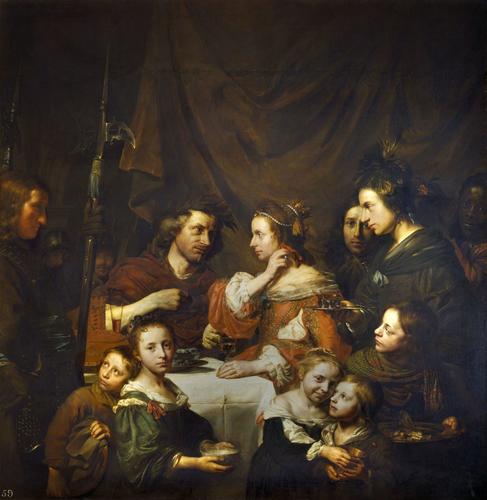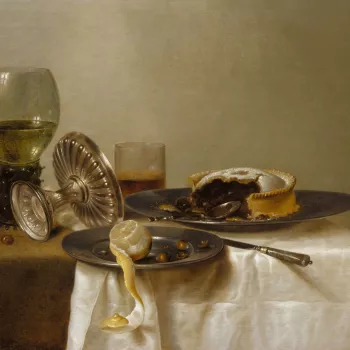The Banquet of Cleopatra Signed and dated 1652
Oil on canvas | 170.7 x 165.8 cm (support, canvas/panel/stretcher external) | RCIN 404756
-
The story of the banquet of Cleopatra is recounted in the Natural History of Pliny (Book IX, lines 119-21), which was translated into Dutch in 1660. A more popular, alternative source for the story was Jacob Cats’s description of the banquet in Huwelijk van Antonius en Cleopatra, incorporated into his long poem Trouriugh (Dordrecht, 1637). Pliny related that two of the largest pearls in the world were owned by Cleopatra, Queen of Egypt. She scoffs at her lover, the Roman Mark Antony, and makes a bet with him that she is prepared to spend a fortune on a single feast. Although the meal appears at first to be frugal, Cleopatra wins the bet by removing one of her pearls from her ear and dissolving it in vinegar, which she then drinks. The story was often painted by artists, but not always from a moralising point of view although in seventeenth-century Holland it would have been difficult to escape the imputation of vanity in such a scene.
The Banquet of Cleopatra, which was probably acquired by Charles II, reveals de Bray’s skills as a portraitist albeit in a narrative, historical context. This painting is, in essence, a rather unusual family portrait. Not all the figures can be identified, but the principal ones seated at the table are the artist’s parents: Salomon de Bray as Antony and his wife, Anna Westerbaen, as Cleopatra. The artist himself is at the left edge of the composition holding a halberd. Next to him at the front are two of the younger children - Jacob and one of his sisters - holding a pestle and mortar. Balancing them in the foreground on the right side are perhaps two of the children who died young. To the right of them is Josephas, holding a pewter dish, with another sister behind carrying two rummers on a silver dish. Behind her is another brother, Dirck. Armed attendants and a servant are visible in the background to left and right. The range of utensils made of different materials, and some of oriental origin, attests the geographical reach of the Dutch maritime empire. Aspects of the composition partake of the tradition of still-life painting. It is to de Bray’s credit, therefore, that he reveals not only his ability to paint vivid portraits with a pronounced use of chiaroscuro, but also the textural and reflective qualities of inanimate objects. In 1669 the artist painted another version of the subject with some substantial changes; it is now in the Currier Gallery of Art, New Hampshire. This is larger, with the composition considerably extended at the lower edge: the still-life on the table is different and the figures in the background on the left have been replaced by a peacock. The emphasis in the present picture is more on the portraits, which suggests that the artist perhaps intended the second version to be a memorial picture.
Signed and dated on the tablecloth: JDBray (JDB in Monogram)/1652 and centred beneath signature: 56 (the age of the sitter, Salomon de Bray)
The painting appears in Pyne's illustrated 'Royal Residences' of 1819, hanging as an overdoor in the Queen's Drawing Room at Windsor Castle (RCIN 922102).
Catalogue entry adapted from Enchanting the Eye: Dutch paintings of the Golden Age, London, 2004Provenance
Acquired by Charles II
-
Medium and techniques
Oil on canvas
Measurements
170.7 x 165.8 cm (support, canvas/panel/stretcher external)
186.5 x 182.3 x 9.5 cm (frame, external)
Category
Object type(s)
Other number(s)










